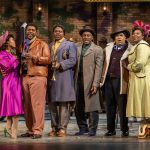2003-12 Vital Source Mag – December 2003
Living Without Santa
By Lucky Tomaszek One night in December of 1978, when I was 6 years old, I stayed up very late watching a toy drive on TV. As I gazed longingly at all the dolls and drums and toy trains piled up for needy children, the host announced the arrival of Santa Claus — he was coming to pick up the toys! I was so excited that I sat straight up on the couch to get a better look. “Ho Ho Ho!” shouted a deep voice, and I got goosebumps. I could hear him stomping onto the set and suddenly, there he was! He was tall and round, dressed in a red velvet suit with black boots. And he was African American. I watched in bewilderment as this jolly Santa picked up the collected toys and thanked the viewing audience for their generosity. The Truth comes out. The next morning, I had a million questions for my mom about the toy drive. I started with questions about the toys I had seen and who would be getting them. Then I said, “Why was Santa on TV black, and Santa at the mall white? How can he change his skin like that?” Then and there, she told me the whole truth, straight out, with no holds barred. I was devastated. I felt like the adults were pulling off the biggest conspiracy ever. I told my mom I needed to get to school right away and tell all of my friends The Truth. We were being lied to, and it had to stop. Mom explained that I really shouldn’t tell the other kids, as it would make them sad. I didn’t understand it — I was taught not to lie. And in our radical house, I was also taught to stand up for injustice and help others in need. In my kindergarten mind, explaining The Truth to all of the other kids was merely fulfilling what I was already seeing as my role in life. Despite her advice, my mom was called to pick me up early that day, but not until I’d broken the hearts of four or five of my classmates. The true meaning of Santa. As I started planning my own family, I knew I wanted Christmas in my house to be different from what I felt it had become for most Americans. At the time, I was in the middle of spiritual crisis, unsure of my beliefs regarding Christianity and the role of the holiday in our culture. As a long-time retail professional, I detested the shopping and the spending and the consuming. But I didn’t have my own set of beliefs around which to build a “new” holiday celebration. I was a little lost. My first baby was born in July of 1995 and I spent the next 5 months pondering how I was going to present Christmas to her. My husband and I exhaustively discussed the holiday and what message we really wanted her to take with […]
Dec 1st, 2003 by Lucky TomaszekIraq’s Catch-22
By Paul McLeary “That’s some catch, that Catch-22,” Yossarian observed. “It’s the best thing there is,” Doc Daneeka agreed. — Joseph Heller, Catch 22 Like much else in the Iraq today, the number of unemployed Iraqis remains a subject of some speculation. The chaos that still reigns on the ground more than six months after the president famously declared “major combat operations in Iraq have ended” precludes a serious tallying of many things — the death toll, crime rates, and unemployment statistics are just a few. What we do know is that in late May, Presidential Envoy to Iraq Paul Bremer disbanded the Iraqi army, putting some 400,000 troops and support personnel out of work in one fell swoop. While some unofficial estimates claim that up to 60 percent of Iraqis are unemployed, many of these reports are of, as they say, suspect authenticity. The closest thing we have to an official figure was released in October by Minister of Labor and Social Affairs Sami Azara al-Majoun, who estimated 8.5 million jobless Iraqis. In a country of 23 million people, that’s nothing short of devastating. Adding to the problem is an estimate that more than 10,000 Iraqi plants and workshops are either out of service or working at a mere 10 percent of their prewar capacity. Given these facts, it’s easy enough to conclude that the Coalition Provisional Authority (CPA), headed up by Bremer, needs to start making some serious headway in rebuilding the infrastructure and getting people back to work. The solution seems self-evident. Rebuild the economy along with the roads. With Iraq’s infrastructure literally having to be rebuilt from the ground up, the solution would seem self-evident. You have billions of dollars coming in for reconstruction projects, and a pool of millions of unemployed desperately in need of a job. In a well-coordinated effort, two proverbial birds could be killed with one stone. The money could be directly poured into kick starting the local economy by paying Iraqis to rebuild roads, utilities and schools. But it’s not playing out this way. Many U.S. subcontractors tasked with rebuilding Iraq are refusing to hire Iraqis to do the work, opting instead for cheaper migrant labor from South Asia. In a Financial Times article in October, Colonel Damon Walsh, head of the CPA’s procurement office, was quoted as saying “We don’t want to overlook Iraqis, but we want to protect ourselves. From a force protection standpoint, Iraqis are more vulnerable to a ‘bad guy’ influence.” The same piece also quoted a Pakistani manager in Baghdad for the Tamimi Company, which is contracted to cater for 60,000 soldiers in Iraq, as saying “Iraqis are a security threat. We cannot depend on them.” Costs could be reduced by up to 90�But that would be bad for the economy. Some in Congress are making noise about this potentially disastrous situation. This past September, Rep. Henry Waxman (D-Calif.), Ranking Minority Member of the Committee on Government Reform, sent a letter to director of the White […]
Dec 1st, 2003 by Vital ArchivesFrizell Bailey understands the blues.
By Frizell Bailey 2003 has been dubbed the Year of the Blues, marking the 100th anniversary of W.C. Handy’s making some of the first blues recordings in 1903. I grew up in a Mississippi town so small that we had only one stoplight until they took it down in favor of stop signs a number of years ago. The town was small but the blues was large. At most gatherings, and in the hand full of bars in our tiny downtown, blues was what you expected to hear. There was a radio station in Jackson, the only real city in the state, that played all blues, except for a hip hop show late nights and gospel programming on Sundays. I hated the blues. For me it represented everything I wanted to separate myself from. Blues was the music of the downtrodden, the destitute and the uneducated. Desperately trying not to be the small town boy that I was, I turned away from the folksy sound that permeated my childhood. It wasn’t until moving to Jackson to attend college in ’91 that I began to appreciate the blues. It was a three-pronged process, beginning with a part-time job at the largest independent record shop in town, where I suddenly had all manner of music at my disposal. Then there was the influence of the store’s owners and my coworkers, who seemed to agree with Louis Armstrong. “If it sounds good, it is good.” So I gave everything I could a fair listening, from Aabba to Frank Zappa. The groundwork was laid. In 1997 I began teaching in the Mississippi Delta. For those unfamiliar, the Delta is the poorest region in the country. But it is also the birthplace of the blues. Many of the biggest names in the blues came out of this region, from B.B. King and Robert Johnson to Elvis Presley. He may be known as the king of rock and roll, but Elvis was first and foremost a blues man. It’s easy to see why the blues was born in this area. The land is rich, but the people are poor. Even today, most people work in agriculture or don’t work at all. It was amazing how much this land affected me. I finally began to get it. The final phase in the development of my appreciation of the blues occurred at the Subway. The Subway is a juke joint in Jackson offering some of the best live blues in America for a mere $5 cover. Located in the basement of a building that used to house the only hotel where black people could get reservations, Subway sells cans of beer on ice in a bucket and “blues” dogs at the house next door. Friday and Saturday nights, the joint is jumping. People crowd into the tiny space, black and white alike, and stand shoulder-to-shoulder, bodies gyrating, souls engulfed by the music. Whereas I once winced at the sound, today my heart swells, soaked to the core with […]
Dec 1st, 2003 by Frizell BaileyNatalie Merchant
By John Hughes NATALIE MERCHANTHouse Carpenter’s DaughterMyth Americawww.nataliemerchant.com Natalie Merchant has done a righteous thing. She has, of her own free-will, allowed her recording contract with Elektra to lapse, and her fame to diminish, for the sake of artistic control and integrity. What she’s done with her newfound freedom is establish her own record label, Myth America, and create a new CD, House Carpenter’s Daughter, which is now in stores on a limited availability basis. The new CD can be taken as an indication of where she will be headed musically for the foreseeable future. She’s delving into core American musical history, dusting folk greats off for present enjoyment. The entire package of this CD is encountered as a work of art, not just music. The liner notes are articulate and personable, and the photo and art montages, credited to Miss Merchant, are tasteful. Her song selection, a blend of archaic and contemporary, is impeccable, and the musicianship surrounding her singing (a basic rock arrangement judiciously augmented by banjo, fiddle and accordion) is flawless on each song. There is not a note out of place. The album has a rustic, relaxed feel. As always, Merchant’s lovely voice — warm, bold and sensual — is the centerpiece of the disc. This album is like comfort food for the ears. There are four standout tracks, “Sally Ann,” “Weeping Pilgrim,” “Owensboro” and “Wayfaring Stranger,” each playing at the edges of serious beauty, tugging the heartstrings with a sense of Americana mystery. “Soldier Soldier” and “Down on Penny’s Farm” relax the mood considerably and also bring a note of humor. But, as she’s been throughout most of her career, Merchant is understated, basically restrained. This is not a party album, or one for driving with in a fast car. It’s a perfect, thoughtful companion for being cozy indoors on a rainy or freezing day.
Dec 1st, 2003 by Vital ArchivesRickie Lee Jones
By John Hughes RICKIE LEE JONESThe Evening of My Best DayV2 Recordswww.rickieleejones.com Rickie Lee Jones’ new CD The Evening of My Best Day feels like two separate outings rolled into one. The first three songs make up Outing #1, and they are not compelling. They sound like a reprise of her great album “Pirates,” diluted heavily with a poor woman’s version of “The Hissing of Summer Lawns.” Cheerful flutes were never cool. The album then whips around a corner, beginning with the fourth song, “Little Mysteries,” and from that point on, for nine consecutive songs, Jones and band unveil a highly original sound. The songwriting is exploratory, novel, accessing the further reaches of pop creativity. The vocalizing, musicianship and production values synthesize to create an unprecedented experience for the listener. It’s as if Jones has invented a new genre of music. The effect of listening to this music must be something similar to the experience viewers had when first seeing Expressionist painting. Your primary reaction is a question, like ‘what’s she doing here?’ or ‘What is this?’ It’s an experiment in mystery through which flit the ghosts of soul, blues, gospel, jazz, folk and rock music forms. It’s a survey of human emotions, a cataloguing, from the foundational perspective of erotic melancholy. She signed some of the finest musicians available to help her on this journey: Los Lobos’ David Hidalgo, Ben Harper, bassist Rob Wasserman, her longtime associate Sal Bernardi, guitarist Bill Frisell, and rock iconoclast Grant Lee Phillips, along with her co-producer, David Kalish. The talent was allowed to breathe; you can feel their playfulness and good chemistry in every cut. Jones has made so much outstanding music in her career, with so little fanfare, that she can be called The Anonymous Legend. The last nine songs here are the most convincing evidence she’s ever recorded of that epithet.
Dec 1st, 2003 by Vital Archives















